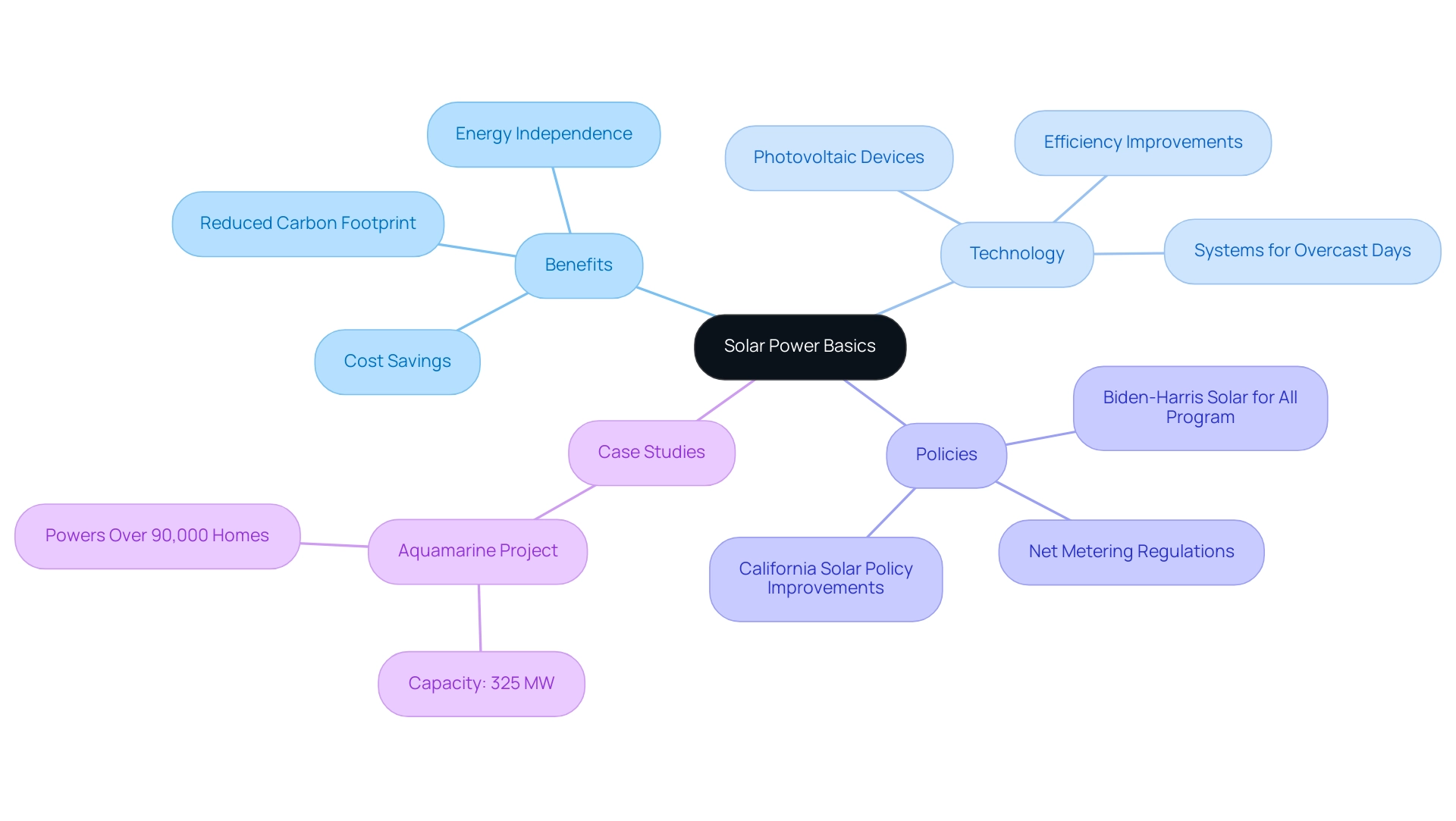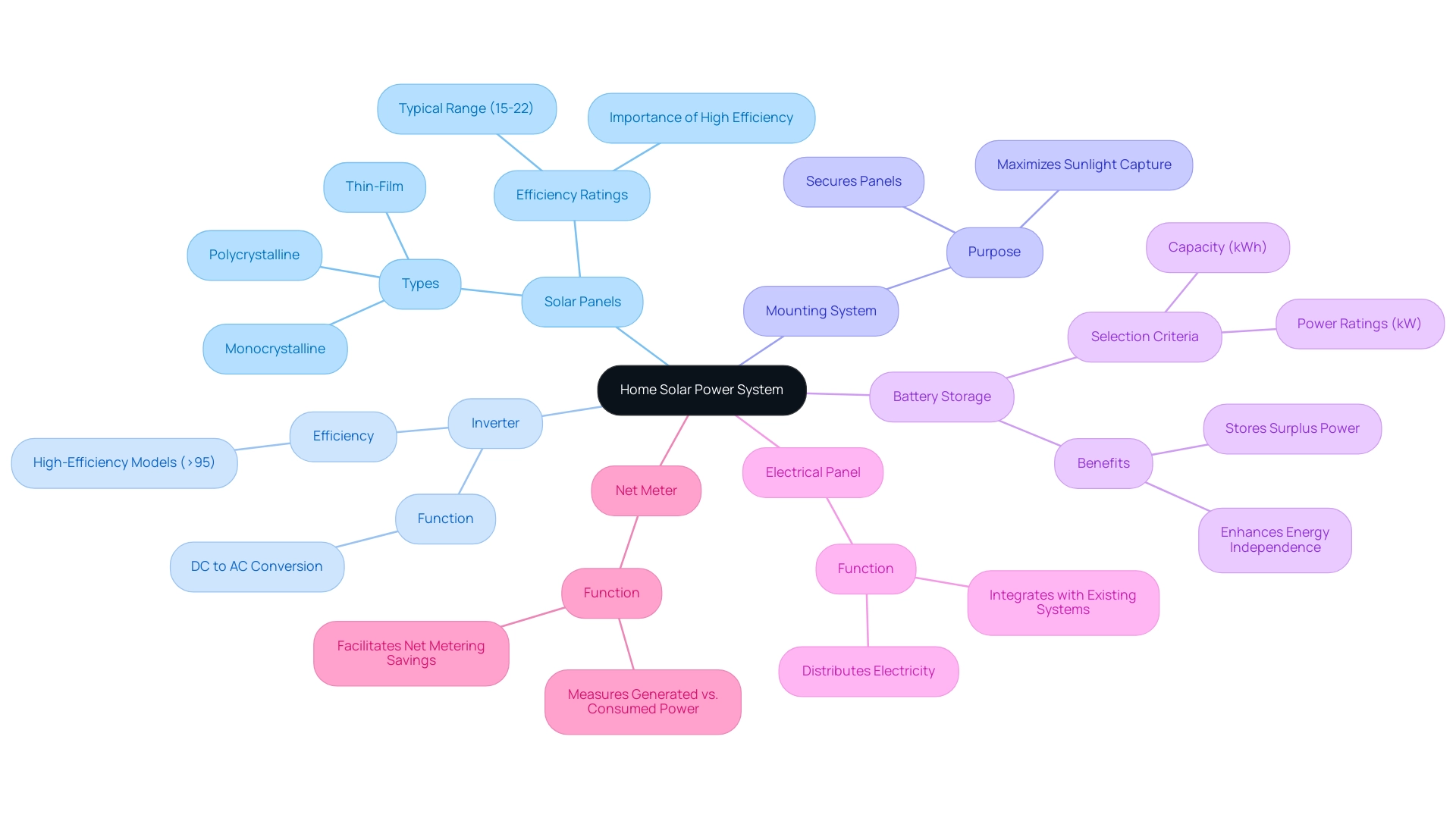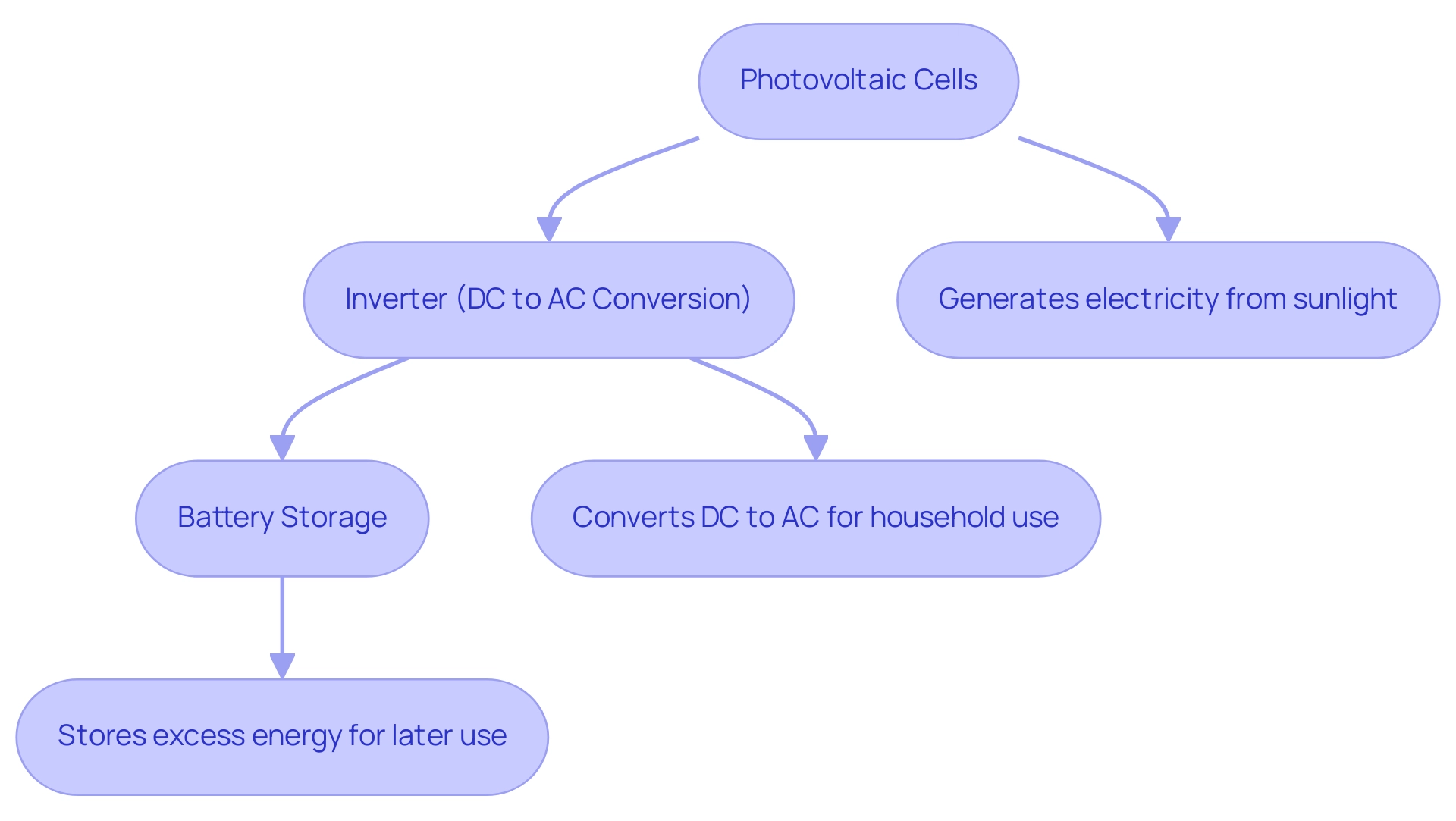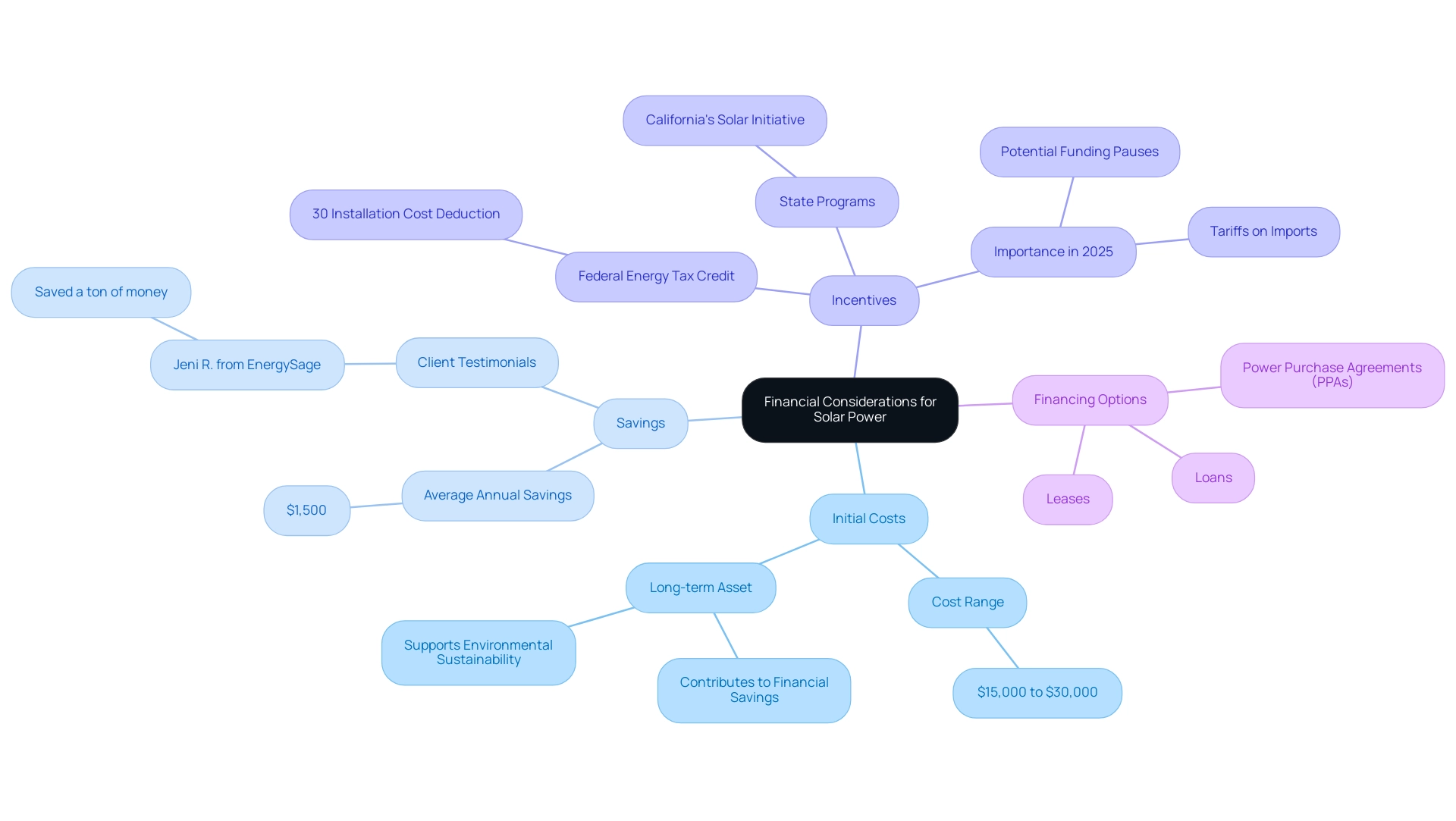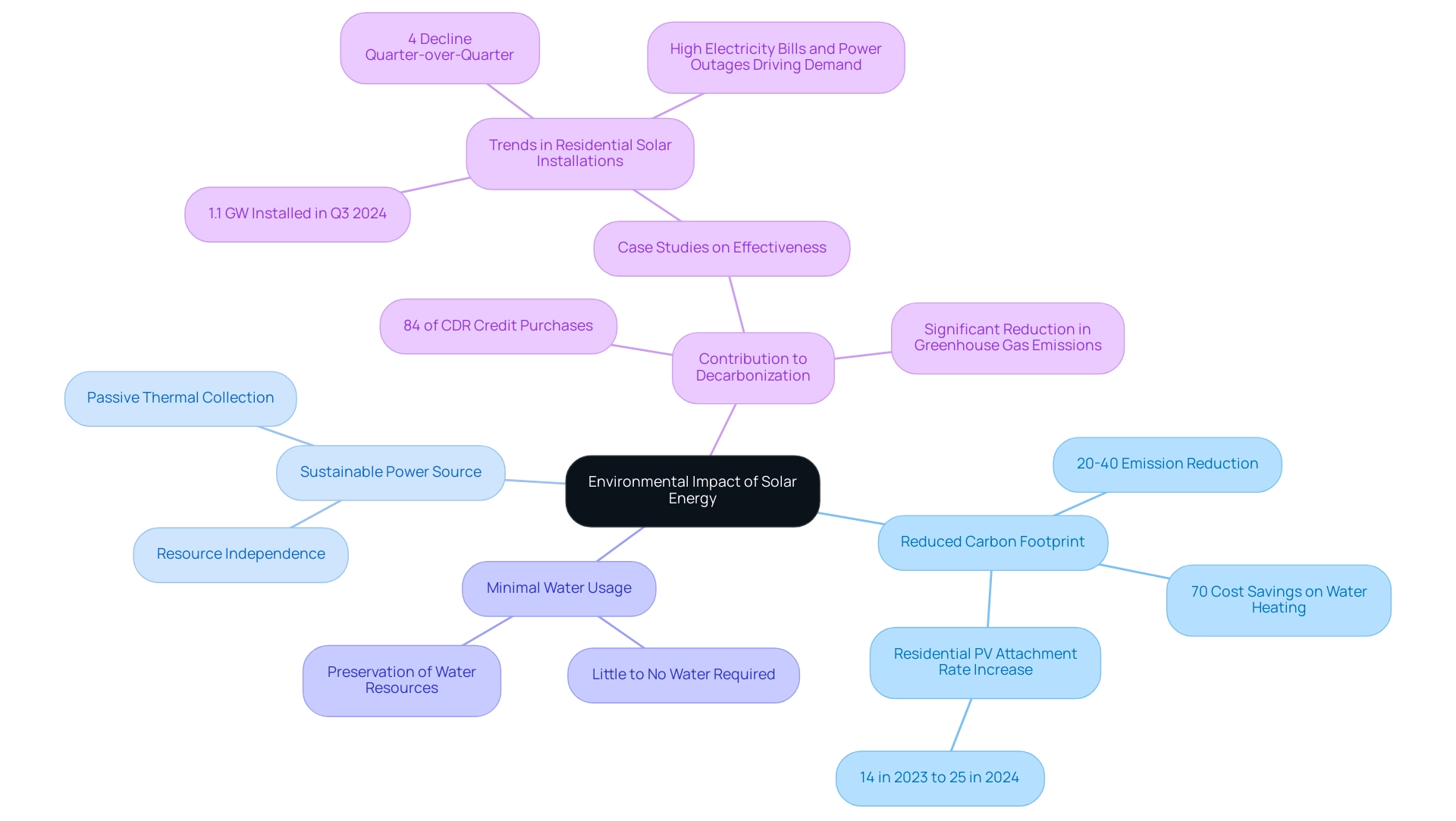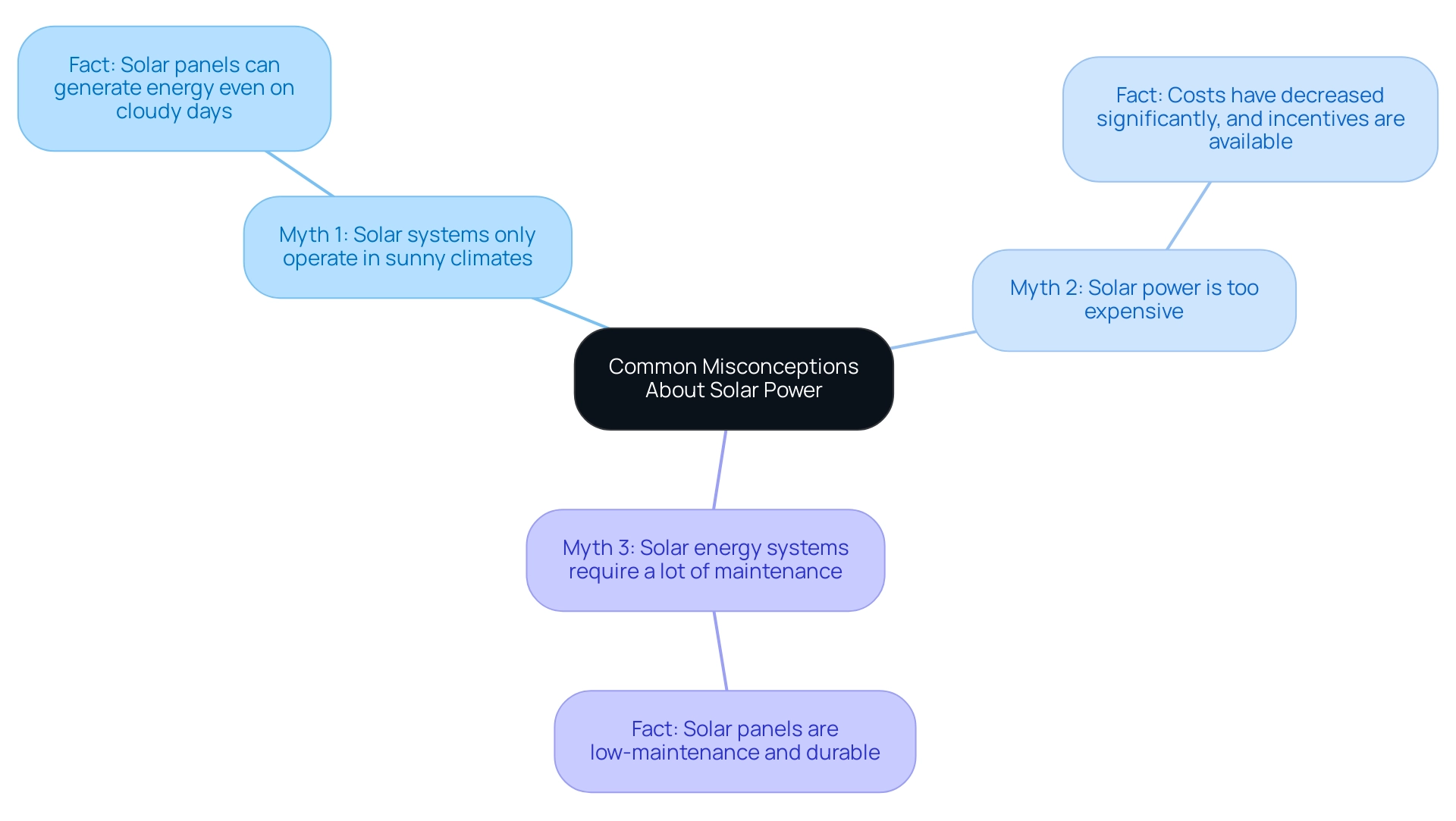Overview
We understand that rising energy bills can be a source of concern for many homeowners. Home solar power offers a compassionate solution by converting sunlight into electricity through photovoltaic panels. These panels capture solar energy, transforming it into usable power for your home. This process involves several key components, including:
- Solar panels
- Inverters
- Battery storage
These components work together to empower you to generate your own electricity. By embracing solar energy, you can reduce your reliance on fossil fuels and contribute to a more sustainable environment.
Imagine the peace of mind that comes with energy independence. With solar power, you are not just saving money; you are also making a positive impact on our planet. Together, we can create a cleaner future for generations to come. If you’re curious about how solar energy can benefit you, let’s explore this journey together. We’re here to support you every step of the way, ensuring you feel confident and informed in your decision to harness the sun’s energy.
Introduction
In a time when many of us are increasingly aware of our impact on the environment, solar power shines brightly as a source of hope for homeowners eager to lower their energy bills and carbon footprints. We understand that rising energy costs can be a concern, and with the latest advancements in technology, solar energy has become more efficient and accessible than ever. This makes the transition to this renewable resource not just appealing, but also a practical choice for a sustainable future.
This article will explore the fundamentals of solar power, highlighting its numerous benefits, essential components, and the installation process. We will also address some common misconceptions that might hold you back from making this important switch. As the solar landscape evolves, understanding the financial incentives and environmental impacts of solar energy can empower you to make informed decisions. Together, we can work towards a brighter, more sustainable future.
Understanding Solar Power: The Basics
Solar power comes from the sun’s rays, a renewable and nearly limitless resource that can be converted into electricity or heat. We understand that many residents are looking for ways to decrease their carbon footprint and cut down on utility costs. This sustainable power choice is becoming more attractive, especially as the main technology for capturing sunlight—photovoltaic devices—are often set up on rooftops. These panels collect sunlight and transform it into usable power, enabling homeowners to produce their own electricity.
In 2025, California remains at the forefront of the country in renewable energy adoption, with about 29% of its electricity generated from such sources. This important contribution highlights the state’s dedication to sustainable resources and its advantageous net metering regulations, which allow residents to sell surplus sunlight power back to the grid. Such policies not only enhance energy independence but also offer financial incentives for property owners to invest in renewable technology, making it a financially viable choice.
The advantages of renewable energy for property owners extend beyond cost savings. By shifting to renewable energy, homeowners can significantly reduce their carbon footprint, contributing to a cleaner environment. Recent advancements in photovoltaic technology have further enhanced efficiency and affordability, with the cost of residential panels having decreased by 40% over the past decade, according to the Solar Energy Industries Association. This trend makes sunlight power more attainable than ever.
Economic and environmental advantages of sunlight heating systems are significant as well. Investing in renewable energy technology not only shields property owners from the fluctuations of electricity expenses but also diminishes reliance on fossil fuels. Furthermore, initiatives like the Biden-Harris administration’s $7 billion Solar for All program aim to enhance access to renewable power, ensuring that the benefits of photovoltaic technology are distributed fairly among communities.
Case studies, such as the Aquamarine project in Lemoore, which boasts a capacity of 325 MW and can power over 90,000 homes, illustrate the potential of this technology to meet large-scale power demands while promoting sustainability. This project illustrates how extensive renewable initiatives can advantage property owners by enhancing the overall capacity and dependability of sunlight power in the area. Furthermore, continuous legislative initiatives by groups such as the Solar Energy Industries Association seek to improve California’s renewable energy policies, ensuring that residents can maximize the advantages of distributed energy systems. These initiatives aim to establish a more conducive atmosphere for renewable energy uptake, further motivating property owners to explore alternative power options.
Grasping how home solar power works and its benefits is crucial for property owners contemplating this environmentally friendly power solution. By adopting sunlight power, they not only invest in their own power future but also contribute to a more sustainable world. For individuals in Stockton, investigating nearby energy companies, including Powercore Electric, can offer customized solutions that address specific requirements, ensuring that residents can effectively navigate the installation process and maximize their energy advantages.
Moreover, homeowners should contemplate photovoltaic systems specifically created for overcast days, which can enhance power collection even in suboptimal weather conditions. Thorough instructions on the installation procedure and appropriate sizing of photovoltaic modules are essential for optimizing the advantages of renewable power.
Key Components of a Home Solar Power System
As homeowners, we often find ourselves concerned about rising energy bills and the impact they have on our budgets. A typical home solar power system can be a beacon of hope, offering a way to harness the sun’s energy effectively while reducing those costs. Understanding the essential components of such a system can pave the way toward energy independence and sustainability.
- Solar Panels are at the heart of this transformation. These crucial devices convert sunlight into electricity, predominantly made of silicon. The most common type installed today is monocrystalline, celebrated for its high efficiency, which typically ranges from 15% to 22%. Almost 100% of home-installed photovoltaic systems belong to this category, showcasing a significant shift toward optimizing power conversion. For those living in cloudier regions, it’s vital to select solar modules designed to perform well in low-light conditions. As Daniel Ciolkosz, a professor at Pennsylvania State University, notes, “If something is 20% efficient, that means that 20% of the energy in that sunlight reaching the photovoltaic module gets converted into moving electrons.” This underscores the importance of choosing high-efficiency units. At Powercore Electric, you’ll find a variety of photovoltaic modules tailored for different environmental conditions.
- Next, we have the Inverter, a vital component that transforms the direct current (DC) produced by the solar panels into alternating current (AC), the type of electricity most household devices use. The efficiency of inverters can significantly impact the overall performance of your solar power system, with high-efficiency models achieving over 95% efficiency.
- The Mounting System secures the solar panels to your roof or ground, ensuring they are optimally positioned to capture sunlight throughout the day. Proper installation is essential for maximizing power generation and extending the lifespan of your panels.
- While Battery Storage is not mandatory, it is becoming increasingly beneficial. These systems allow you to store surplus power generated during the day for use at night or during outages, enhancing your energy independence and reliability. When selecting a battery, consider its capacity (measured in kilowatt-hours) and power ratings (measured in kilowatts) to ensure it meets your needs effectively. Powercore Electric offers a range of battery solutions designed for residential storage requirements.
- The Electrical Panel then distributes the electricity produced by your solar system throughout your home, integrating seamlessly with your existing electrical systems to ensure efficient power use.
- Lastly, a Net Meter measures the power generated by your solar system against the power consumed from the grid. This allows you to benefit from net metering policies, potentially leading to significant savings on your electricity bills.
As the energy industry evolves, understanding how home solar power works and its components is crucial for homeowners considering renewable energy solutions. Recent challenges, such as rising financing costs and changes to California’s Net Metering rules, have affected residential renewable energy installations, leading to a projected down year in 2024. In Q3 2024, 1.1 GW of residential photovoltaic systems were installed, marking a 4% decline quarter-over-quarter.
We encourage you to stay informed about the latest technologies and market trends to make educated decisions about your energy investments. The significance of selecting the appropriate photovoltaic module cannot be overstated; efficiency ratings can vary greatly, affecting your overall power generation. Additionally, exploring local energy companies in Stockton, including Powercore Electric, can provide you with tailored solutions and support for your solar projects. Together, we can work towards a brighter, more sustainable future.
The Photovoltaic Effect: How Solar Panels Generate Electricity
Understanding the photovoltaic effect is crucial for grasping how home solar power works, as it allows collectors to transform sunlight into usable electricity. When sunlight reaches the cells within these systems, it energizes electrons, creating an electric field that facilitates the flow of electricity. This process generates direct current (DC) electricity, which can be converted into alternating current (AC) for use in homes.
We know that several key factors influence how home solar power operates, particularly the effectiveness of photovoltaic modules in harnessing this energy. The type of photovoltaic technology used—be it monocrystalline, polycrystalline, or thin-film—plays a significant role in efficiency rates. Additionally, the angle at which sunlight hits the surfaces, known as the angle of incidence, is vital for maximizing energy capture.
Environmental conditions, such as temperature and shading from nearby buildings or trees, also affect how home solar power functions. As of 2025, advancements in solar technology have led to remarkable improvements in efficiency, with many high-performance panels exceeding 22%. This increase is a testament to ongoing research and development in the photovoltaic field. Recent studies indicate that under optimal conditions, the photovoltaic effect can achieve efficiency rates of up to 30%, showcasing the potential for even greater energy generation.
Real-world examples underscore these advancements. Numerous case studies highlight how sunlight-powered heaters have made a difference in various homes. For instance, a household in Southern California experienced a remarkable reduction in utility costs—over 70%—after installing a water warming system paired with a heat exchanger.
This setup not only resulted in significant savings but also supported their sustainability efforts by lowering their carbon footprint, prompting an inquiry into how home solar power works. Moreover, many homeowners have reported substantial savings on energy costs and enhanced self-sufficiency after adopting high-efficiency photovoltaic systems. Understanding how home solar power operates also involves incorporating power storage solutions, enabling the use of sunlight even on cloudy days, which enhances overall effectiveness and reliability.
According to estimates from the Energy Department, solar-powered water heating systems can save residents between $400 to $600 annually on utility bills. Expert insights emphasize the importance of understanding how home solar power works and the photovoltaic effect, along with its implications for energy converter efficiency. Researchers highlight that as technology continues to advance, the effectiveness of photovoltaic panels will keep improving, raising essential questions about how home solar power can be a progressively viable choice for those seeking sustainable energy solutions.
Additionally, it’s important to note that as of 2021, women comprised 40% of the workforce in the photovoltaic industry, showcasing the diversity within this expanding field. However, challenges such as noise pollution from PV systems during installation and operation must be effectively managed to minimize disturbances in residential neighborhoods. Powercore Electric’s dedicated team of experts ensures high-quality installations and maintenance, addressing these concerns while providing dependable service.
By harnessing the sun’s power, homeowners can not only reduce their expenses but also contribute to a cleaner, more sustainable future. As the global market for solar solutions continues to grow, with forecasts indicating significant expansion, the interest in renewable energy alternatives is more relevant than ever. Together, we can work towards a brighter, more sustainable future.
From Sunlight to Usable Energy: Conversion and Storage
We understand that many homeowners are concerned about rising energy bills and the reliability of their power sources. Once photovoltaic cells produce electricity, the next vital step involves transforming and storing that power. Inverters play a pivotal role in this process by converting the direct current (DC) electricity generated by the panels into alternating current (AC) electricity, which is suitable for home use. This conversion is essential, as most household appliances operate on AC power.
In addition to inverters, many solar power systems incorporate battery storage solutions. These batteries enable residents to retain surplus power produced during sunny times for future use, ensuring a dependable power source even when the sun isn’t shining. This capability is increasingly important as homeowners seek to enhance their energy independence and reduce reliance on the grid.
Key considerations for selecting a battery include:
- Capacity
- Efficiency
- Lifespan
- Price
- Ecological benefits
These factors are critical for making informed decisions that align with your energy goals.
Recent trends indicate that the residential photovoltaic inverter market is shifting towards advanced technologies and smart inverter systems. According to a case study on this market, these innovations not only enhance the efficiency of energy integration but also align with consumer demands for reliability and performance. In fact, statistics indicate that 78% of installers expect a rise in sales in 2025, reflecting a growing interest in advanced renewable solutions.
As Laura Onnis, CEO of a prominent integration firm, observes, “Incorporating renewable resources on highway systems is a crucial advancement towards optimizing sunlight utilization in daily applications.”
Moreover, the significance of battery storage in photovoltaic systems cannot be overstated. As power storage technologies evolve, they are becoming more valuable to grid operators, particularly as renewable assets penetrate the grid. Efficient resource management through the use of inverters and battery storage can significantly enhance savings and efficiency for property owners, making the shift to renewable power not only sustainable but also economically beneficial.
The evaluation of battery types, including lead-acid, lithium-ion, and flow systems, offers residents options that best meet their storage requirements.
At Powercore Electric, we focus on tailored service and assistance, guaranteeing that our internal team of specialists aids in the successful execution of renewable power systems for residents. In summary, understanding how home solar power works, including how sunlight is transformed and stored, is crucial for homeowners aiming to enhance their power systems. By utilizing advanced inverters and dependable battery storage, they can guarantee a consistent power supply while contributing to a more sustainable future. Together, we can navigate this journey towards energy independence, ensuring a brighter tomorrow for all.
Installing Solar Panels: What Homeowners Need to Know
Installing solar panels can feel like a daunting task, but understanding the structured process can alleviate your concerns and lead to a rewarding outcome. Here’s a compassionate guide to ensure optimal performance and compliance with regulations:
- Site Assessment: We begin with a thorough evaluation of your roof’s condition, orientation, and shading. This assessment is critical to determine your home’s energy potential. Factors like roof angle and surrounding trees can significantly impact energy generation. By grasping how home solar power works with photovoltaic panels, you can make informed choices during this phase.
- Design and Permitting: Collaborating with a qualified installer, such as Powercore Electric, allows you to design a system tailored to your specific needs. This phase includes obtaining necessary permits, which can vary by locality. Understanding local regulations is vital to avoid delays in the installation process. With nearly 900 registered installers of renewable energy systems in California, selecting a qualified expert is crucial for a successful installation.
- Installation: The installation team will carefully mount the panels, connect the inverter, and establish the electrical connections. This step requires precision and expertise to ensure that the system operates efficiently and safely. Powercore Electric focuses on providing sustainable, competitively priced energy solutions, ensuring that your installation meets high standards.
- Inspection: After installation, a local inspector will conduct a thorough review to verify that the system adheres to safety and building codes. This step is essential for ensuring that your energy installation is compliant and ready for activation.
- Activation: Once the system passes inspection, it can be turned on, enabling you to begin producing power. This signifies the start of your journey towards autonomy in power and cost savings.
Key Points:
- Proper assessment and design are crucial for effective solar installations, as they directly influence the system’s efficiency and longevity. Homeowners should also consider local incentives and rebates for photovoltaic installations in Bakersfield, which can encourage renewable resource adoption and reduce overall expenses.
- Ensuring your installer is licensed and experienced can significantly affect the quality of the installation. Photovoltaic panels can also enhance home value, particularly in regions with favorable net metering policies and energy rebates.
- Understanding the installation procedure aids in managing expectations and prepares individuals for the shift to renewable power.
Statistics suggest that property owners who invest in renewable installations frequently experience heightened satisfaction, with many noting substantial savings on utility expenses. Additionally, taking advantage of available incentives and rebates can significantly lower the overall investment, making renewable energy more accessible and appealing. As Jeni R. noted, “EnergySage saved me a ton of money by helping me get bids that were half the cost of the bids I got myself by calling around.
I can’t say enough good about this organization. Don’t invest in renewable energy without it!” This highlights the importance of working with knowledgeable professionals during the installation process. Together, we can navigate this journey towards a sustainable future.
Financial Considerations: Costs, Savings, and Incentives
Investing in solar power can feel overwhelming, especially when considering the financial implications that can significantly influence your investment and its long-term benefits:
- Initial Costs: The average cost of a residential solar system typically ranges from $15,000 to $30,000, influenced by the system’s size and the components selected. While this initial investment may seem daunting, it’s essential to view it as a long-term asset that not only contributes to your financial savings but also supports environmental sustainability. Traditional electricity expenses can accumulate significantly over time, making renewable energy a more appealing choice in the long run.
- Savings: Homeowners can expect substantial savings on their electricity bills, with average annual savings estimated at around $1,500. Over time, these savings can accumulate, effectively offsetting the initial expenses of the energy installation. As shared by satisfied clients, including Jeni R. from EnergySage, seeking professional guidance can lead to considerable cost savings, making the transition to renewable sources more economically feasible.
- Incentives: Federal and state incentives play a crucial role in making renewable energy more affordable. For instance, the federal energy tax credit allows homeowners to subtract 30% of the installation expenses from their federal taxes, greatly reducing the initial financial burden. Additionally, various state programs provide rebates and incentives, such as California’s Solar Initiative, which can further enhance the financial viability of investments in renewable energy. As the renewable energy sector faces uncertainties in 2025, such as potential funding pauses and tariffs, the importance of state incentives becomes even more pronounced, ensuring continued demand and support for renewable solutions.
- Financing Options: To make renewable power more accessible, numerous financing choices are available, including loans, leases, and power purchase agreements (PPAs). These options empower property owners to select a payment arrangement that best suits their financial circumstances, facilitating the shift to renewable power without a substantial initial cost.
Understanding these financial considerations is vital for effective budget planning. By utilizing available incentives and financing alternatives, homeowners can decrease their overall investment while enjoying the long-term advantages of renewable power. Ultimately, investing in photovoltaic energy not only contributes to financial savings but also plays a significant role in reducing carbon emissions, with a 5 kW system offsetting approximately 4,200 pounds of CO₂ emissions annually—equivalent to planting 50 trees.
At Powercore Electric, our internal team of specialists guarantees high-quality installations and maintenance, reinforcing our dedication to dependable and efficient solutions for California communities. As Ryan, a satisfied customer, shared, “I have referred Powercore to some friends and they were also happy with their service. I’d definitely recommend Ryan and Powercore Electric.”
This reflects our commitment to customer satisfaction and community involvement. Together, we can work towards a more sustainable future.
The Environmental Impact of Solar Energy
Solar energy presents a multitude of environmental benefits that are increasingly vital in today’s climate-conscious world:
- Reduced Carbon Footprint: We understand that energy bills can be a concern for many homeowners. Utilizing solar power dramatically decreases greenhouse gas emissions compared to traditional fossil fuels. This shift is vital as residential photovoltaic attachment rates are anticipated to increase from 14% in 2023 to 25% in 2024, indicating a rising dedication to cleaner power solutions. Importantly, sunlight-powered air heaters can lower a household’s carbon emissions by 20 to 40 percent. Moreover, water heating systems utilizing sunlight have demonstrated the ability to cut costs by over 70% in certain instances, greatly aiding sustainability initiatives. For instance, a household in Southern California experienced an impressive decrease in their utility expenses after setting up a water warming system combined with a heat exchanger.
- Sustainable Power Source: As a renewable and plentiful resource, sunlight plays a pivotal role in enhancing power independence. Homeowners can reduce their reliance on non-renewable resources and contribute to a more sustainable future. You might wonder, how does home solar power work? For instance, a residence employing large south-facing windows for passive thermal collection has shown considerable resource savings during winter months, highlighting the varied uses of sunlight technologies, especially in cooler areas.
- Minimal Water Usage: It’s common to feel concerned about resource depletion. Unlike traditional power generation methods, which often require significant water resources, photovoltaic systems operate with little to no water. This trait not only preserves essential water resources but also reduces the environmental effects linked to water-intensive power generation.
Professional insights highlight the ecological benefits of sunlight power and explain how does home solar power work. Carolyn Amon, a research leader at the Deloitte Research Center for Energy and Industrials, emphasizes that “decarbonization strategies are essential for mitigating climate change, and sunlight power plays a crucial role in this transition.” Furthermore, studies show that credits produced from renewable-powered techniques represent 84% of carbon dioxide removal (CDR) credit acquisitions, emphasizing the growing acknowledgment of renewable sources’ contribution to alleviating climate change.
Moreover, the expected contributions of photovoltaic (PV) systems to decreasing greenhouse gas emissions are significant. As the world progresses towards decarbonization, sunlight energy stands out as a key player in achieving these environmental goals. Recent news indicates that photovoltaic technology is expected to significantly contribute to a sustainable future by reducing greenhouse gas emissions and mitigating climate change.
By embracing renewable energy, homeowners not only decrease their carbon footprint but also align with eco-conscious values that prioritize sustainability and environmental stewardship. Together, we can make a difference.
Furthermore, numerous case studies highlight the effectiveness of heating technologies in residential settings, emphasizing their economic and environmental benefits. A recent case analysis on trends in residential photovoltaic installations revealed that despite a slight decline in installations in Q3 2024, the demand for renewable solutions remains strong due to rising electricity costs and power outages, emphasizing the urgency for sustainable practices.
Debunking Myths: Common Misconceptions About Solar Power
Many myths persist regarding this power source, often discouraging homeowners from embracing this sustainable solution. Addressing these misconceptions is vital for empowering individuals to make informed choices about their energy needs, especially for eco-conscious renters in Long Beach seeking renewable energy solutions.
- Myth 1: Solar systems only operate in sunny climates.
Fact: We understand that it’s common to believe photovoltaic panels can only generate electricity in sunny weather. However, contrary to popular belief, these panels can produce energy even on cloudy days. They are designed to capture diffuse sunlight, allowing them to generate power in various weather conditions. This adaptability makes renewable power a viable option for homeowners in diverse climates, including those in Southern California. - Myth 2: Solar power is too expensive.
Fact: It’s natural to be concerned about costs, but the price of photovoltaic technology has significantly decreased over the past decade, making it more accessible than ever. Additionally, various state and federal incentives, such as those available for Tesla home chargers and solar energy installations, can considerably offset initial installation expenses. This makes solar energy an economically viable choice for many homeowners, particularly in solar-friendly states with high electricity rates and attractive incentives. - Myth 3: Solar energy systems require a lot of maintenance.
Fact: We know that maintenance worries can be daunting. However, solar panels are remarkably low-maintenance. Typically, they only need occasional cleaning to remove dust and debris, ensuring optimal performance. Most systems come with warranties lasting 25 years or more, underscoring their durability and reliability.
As Jamie Smith, a Content Specialist, states, “Renewable resources refer to sources of power that naturally replenish themselves within a human lifetime,” emphasizing the long-term advantages of sunlight-derived power.
By debunking these myths, property owners can better understand the benefits of renewable energy, including potential savings on electricity expenses and enhanced energy autonomy. As public perception shifts towards recognizing the advantages of renewable energy, it becomes essential to clarify these misconceptions and highlight the real-world experiences of homeowners who have successfully integrated renewable solutions into their lives. Furthermore, understanding the global context, such as China’s dominance in panel production, can provide insights into market dynamics and the availability of renewable technology for consumers.
This knowledge is especially advantageous for Long Beach renters searching for eco-friendly power solutions. Moreover, examining the economic and environmental benefits of heating systems, which encompass both active and passive solutions, can deepen the understanding of this technology’s long-term sustainability. Together, we can explore these choices and utilize the advantages of renewable power with the support of Powercore Electric.
The Future of Solar Power: Innovations and Trends
The future of solar power is exceptionally promising, driven by a wave of innovations that can truly transform your residential energy solutions. We understand that rising energy bills can be a source of concern, but there are exciting developments on the horizon:
- Increased Efficiency: Ongoing advancements in solar panel technology are resulting in significantly higher efficiency rates. This means you can generate more power from smaller setups, maximizing your roof area and investment, and ultimately reducing those pesky energy bills.
- Enhanced Power Storage Solutions: The latest advancements in battery technologies, such as the newest photovoltaic batteries provided by Powercore Electric, are set to revolutionize storage capabilities. These innovations ensure that renewable power is not only produced but also stored efficiently, giving you a reliable source of electricity even during outages. Assessing leading batteries for power storage uncovers essential attributes and market trends, particularly those provided by Powercore Electric compared to competitors.
- Smart Energy Systems: The integration of renewable technology with smart home systems is on the rise. This collaboration empowers you to enhance your resource consumption and management, leading to smarter, more efficient usage.
Moreover, government incentives, including subsidies and tax credits, can significantly lower the initial installation costs of renewable power systems, making it more attainable for you. As Ben Zientara, a renewable energy policy analyst, notes, “The residential energy industry is evolving rapidly, with innovations that promise to enhance both efficiency and affordability.”
As we approach 2025, the trend suggests that innovations will continue to improve both the efficiency and reliability of systems, including how home solar power works. For instance, the U.S. is anticipated to add 63 gigawatts (GW) of new utility-scale electric-generating capacity in 2025, with photovoltaic energy and battery storage expected to represent 81% of these additions. California is poised to play a significant role in this growth, underscoring the importance of transitioning to renewable power sources.
Additionally, the Kayamkulam Floating Photovoltaic Plant in India showcases the potential of innovative technology for large-scale sustainable power generation, inspiring homeowners like you about the possibilities of harnessing sunlight. In contrast, developers are planning to construct 4.4 GW of new natural gas-fired capacity in the U.S., highlighting the critical need to embrace sustainable power solutions as we move forward.
Together, we can anticipate a future filled with accessible alternatives that not only lower utility expenses but also support a sustainable lifestyle. The emphasis on renewable energy sources, particularly solar and battery storage, is essential for balancing supply and demand in the energy grid. Let’s work towards a brighter, more sustainable future together.
Conclusion
Adopting solar power is not just a choice; it’s a transformative step toward a more sustainable and economically viable future for you and your family. We understand that many homeowners are concerned about rising energy bills. This article has explored the fundamentals of solar energy, highlighting how it can significantly reduce your energy costs while lowering your carbon footprint. With advancements in technology, solar panels have become more efficient and accessible, making it easier for you to harness the sun’s power effectively.
Understanding the key components of a solar power system—solar panels, inverters, and battery storage—is crucial for maximizing energy generation and reliability. The installation process, while structured, offers opportunities for customization, ensuring that you can tailor your system to meet your specific energy needs. Financial considerations, including initial costs, savings, and available incentives, further reinforce the appeal of solar energy, proving it to be a sound investment in both your personal finances and environmental stewardship.
Moreover, addressing common misconceptions about solar energy empowers you to make informed decisions. The environmental benefits of solar power, alongside the promising innovations shaping its future, position solar energy as a vital resource in combating climate change. It’s common to feel unsure about making such a significant change, but as the solar landscape continues to evolve, embracing this renewable energy source not only benefits your household but also contributes to a collective movement towards a cleaner, more sustainable world. Together, we can work towards a brighter future—let’s take this journey together.



